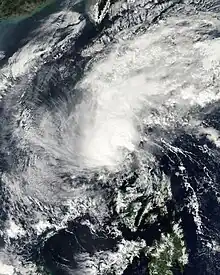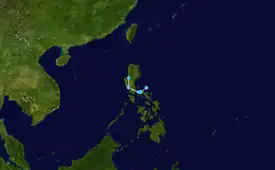Tropical Depression Winnie
Tropical Depression Winnie was a weak, but catastrophic tropical cyclone that killed nearly 1,600 people after triggering widespread flooding in the Philippines. It was the second deadliest tropical cyclone of 2004 worldwide, only surpassed by Hurricane Jeanne. A depression, which formed east of Samar, brought heavy rain to areas where it passed through, and affecting many areas, owing to Winnie’s large cloudiness.
 Tropical Depression Winnie over the Philippines | |
| Meteorological history | |
|---|---|
| Formed | November 29, 2004 |
| Dissipated | November 30, 2004 |
| Tropical depression | |
| 10-minute sustained (JMA) | |
| Highest winds | 55 km/h (35 mph) |
| Lowest pressure | 1002 hPa (mbar); 29.59 inHg |
| Overall effects | |
| Fatalities | 1,593 total |
| Damage | $14.6 million (2004 USD) |
| Areas affected | Philippines |
Part of the 2004 Pacific typhoon season | |
Meteorological history

Tropical storm (39–73 mph, 63–118 km/h)
Category 1 (74–95 mph, 119–153 km/h)
Category 2 (96–110 mph, 154–177 km/h)
Category 3 (111–129 mph, 178–208 km/h)
Category 4 (130–156 mph, 209–251 km/h)
Category 5 (≥157 mph, ≥252 km/h)
Unknown
Tropical Depression Winnie was first identified by the Philippine Atmospheric, Geophysical and Astronomical Services Administration on November 27 as a tropical depression east of the Philippines. A poorly organized cyclone, the Joint Typhoon Warning Center briefly issued a Tropical Cyclone Formation Alert on November 29. Tracking west-northwestward, Winnie made landfall in southern Luzon.[1] Upon moving over land, the depression attained its peak intensity with winds of 55 km/h (35 mph) and a barometric pressure of 1000 mbar (hPa; 29.53 inHg).[2] Once over land, the system began to weaken before entering the West Philippine Sea. Once over water, Winnie turned northwest, moving along the western Luzon coastline throughout November 29. Early on the following day, advisories on the tropical depression ceased. Winnie was last noted off the northwestern coast of Luzon, later that day.[1]
Impact
| Rank | Storm | Season | Fatalities | Ref. |
|---|---|---|---|---|
| 1 | "Haiphong" | 1881 | 20,000 | [3] |
| 2 | Yolanda (Haiyan) | 2013 | 6,300 | [4] |
| 3 | Uring (Thelma) | 1991 | 5,101–8,000 | [5] |
| 4 | Pablo (Bopha) | 2012 | 1,901 | [5] |
| 5 | "Angela" | 1867 | 1,800 | [6] |
| 6 | Winnie | 2004 | 1,593 | [6] |
| 7 | "October 1897" | 1897 | 1,500 | [6][7] |
| 8 | Nitang (Ike) | 1984 | 1,426 | [8] |
| 9 | Reming (Durian) | 2006 | 1,399 | [6][5] |
| 10 | Frank (Fengshen) | 2008 | 1,371 | [nb 1][9][10] |
Although a weak tropical cyclone, Tropical Depression Winnie brought torrential rainfall to much of the Visayas and Luzon. Initial estimates stated that at least 300 people were killed by the storm.[1] However, over time, it was discovered that at least 842 people perished and 751 others were missing, a total of 1,593 people.[11] Damage from the depression was estimated at 678.7 million Philippine pesos (US$14.6 million).[12]
Aftermath
Not long after Winnie devastated the central Philippines, the country was struck by another, more powerful tropical cyclone. Typhoon Nanmadol worsened the situation caused by Winnie and killed another 77 people.
Retirement
Due to the extreme death toll caused by the storm in the Philippines, the name Winnie was later retired. The name was replaced with Warren.
See also
- Other Philippines tropical cyclones that claimed more than 1,000 lives
- Typhoon Bopha (Pablo, 2012)
- Typhoon Haiyan (Yolanda, 2013), deadliest tropical cyclone to strike the Philippines in recent recorded history
- Tropical Storm Washi (Sendong, 2011)
- Typhoon Fengshen (Frank, 2008)
- Typhoon Durian (Reming, 2006)
- Tropical Storm Thelma (Uring, 1991)
- 1881 Haiphong Typhoon
Notes
- The death and missing columns includes deaths caused by Typhoon Fengshen (Frank), in the MV Princess of the Stars disaster.
References
- Gary Padgett (March 27, 2005). "Monthly Tropical Weather Summary for November 2004". Typhoon 2000. Retrieved May 21, 2010.
- Gary Padgett (January 4, 2005). "Monthly Tropical Cyclone Tracks: November 2004". Typhoon 2000. Retrieved May 21, 2010.
- Philippine Storm Surge History. Project NOAH, University of the Philippines. November 23, 2013. Archived from the original on November 8, 2014. Retrieved November 29, 2013.
- Del Rosario, Eduardo D (August 9, 2011). Final Report on Typhoon "Yolanda" (Haiyan) (PDF) (Report). Philippine National Disaster Risk Reduction and Management Council. pp. 77–148. Archived (PDF) from the original on November 5, 2020. Retrieved March 27, 2022.
- Alojado, Dominic (2015). Worst typhoons of the Philippines (1947-2014) (PDF) (Report). Weather Philippines. Retrieved September 25, 2015.
- "10 Worst Typhoons that Went Down in Philippine History". M2Comms. August 3, 2016. Retrieved August 3, 2016.
- Lotilla, Raphael (November 20, 2013). "Flashback: 1897, Leyte and a strong typhoon". Rappler. Retrieved July 10, 2014.
- "Deadliest typhoons in the Philippines". ABS-CBNNews. November 8, 2013. Archived from the original on November 13, 2013. Retrieved November 8, 2013.
- Padua, David M (June 10, 2011). "Tropical Cyclone Logs: Fengshen (Frank)". Typhoon 2000. Archived from the original on December 1, 2010. Retrieved December 31, 2011.
- Rabonza, Glenn J. (July 31, 2008). Situation Report No. 33 on the Effects of Typhoon "Frank"(Fengshen) (PDF) (Report). National Disaster Coordinating Council (National Disaster Risk Reduction and Management Center). Archived (PDF) from the original on September 27, 2013. Retrieved December 31, 2011.
- Agence France-Presse (December 10, 2004). "Philippine storms dead and missing toll nears 1,600". ReliefWeb. Archived from the original on July 7, 2011. Retrieved May 21, 2010.
- http://wb.pagasa.dost.gov.ph/index.php?option=com_content&task=view&id=167&Itemid=176&limit=1&limitstart=23%5B%5D
